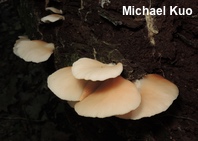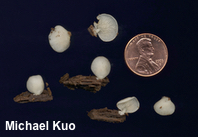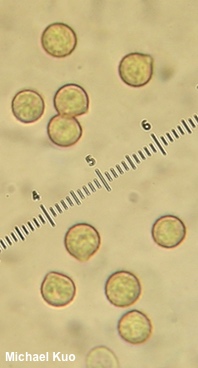| Major Groups > Gilled Mushrooms > Dark-Spored > Pleurotoid Mushrooms > Crepidotus > Crepidotus stipitatus |

|
[ Basidiomycota > Agaricales > Inocybaceae > Crepidotus . . . ] Crepidotus stipitatus by Michael Kuo, 3 August 2023 What saves this tiny Crepidotus from the oblivion of mind-numbing dullness that characterizes the bulk of the genus is the presence of a tiny little stem that attaches the mushroom to its substrate. Of course, the stem is on the underside of the mushroom, and the mushroom maxes out at 3 cm across, so the odds that you will actually see the diminutive stem in order to say "Hey, that's not your average Crepidotus," are pretty low. In fact the only likely scenarios that would lead you to observe the stemlet already involve you bending over to closely inspect a Crepidotus—which means, let's go ahead and face it, you are a mushroom geek. Which means you would have been interested in the thing regardless of the stem-ette. The stem-ito. Under the microscope Crepidotus stipitatus features round, finely ornamented spores, and clamp connections. Description: Ecology: Saprobic; growing scattered, gregariously, or in overlapping clusters on the well-rotted, barkless deadwood of hardwoods; summer and fall; originally described (Kauffman 1918) from Michigan; widely distributed in North America from the Great Plains eastward; occasionally reported rom the Pacific Northwest. The illustrated and described collections are from Illinois. Cap: 4–30 mm across; convex, becoming broadly convex; semicircular to shell-shaped or fan-shaped in outline; bald; whitish or yellowish to brownish; hygrophanous; the margin finely translucent-lined. Gills:: Beginning to run down the stem; close or nearly distant; short-gills frequent; rather thick; white to pinkish at first, becoming dull brownish in maturity. Stem: 2-3 mm long; 1-2 mm thick; attached near the edge of the cap but not quite lateral; bald above, but with a fuzzy base; watery white. Flesh: Soft; thin; whitish; unchanging when sliced. Odor and Taste: Not distinctive. Chemical Reactions: KOH on cap surface negative. Spore Print: Brown. Microscopic Features: Spores 4.5–5.5 µm; globose or subglobose; very finely ornamented-echinulate; brownish yellow to yellow-brown in KOH; inamyloid. Basidia 22–25 x 6–7.5 µm; 4-sterigmate. Pleurocystidia not found. Cheilocystidia 25–35 x 5–7.5 µm; cylindric to clavate or subutriform; smooth; thin-walled; hyaline in KOH. Pileipellis a cutis; elements 2.5–5 µm wide, smooth, hyaline in KOH. Clamp connections present. REFERENCES: C. H. Kauffman, 1918. (Hesler & Smith, 1965.) Herb. Kuo 08070907, 07111603. This site contains no information about the edibility or toxicity of mushrooms. |
© MushroomExpert.Com |
|
Cite this page as: Kuo, M. (2015, May). Crepidotus stipitatus. Retrieved from the MushroomExpert.Com Web site: http://www.mushroomexpert.com/crepidotus_stipitatus.html |


